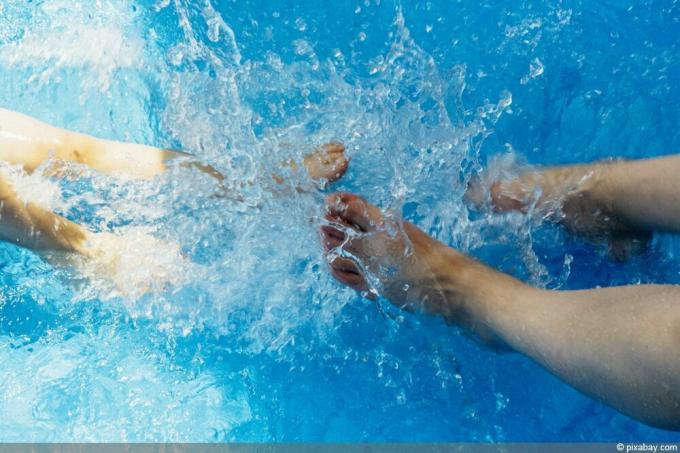

Table of contents
- nature, environment and health
- legal situation
- When to drain pool water?
- Dispose of pool water
- reduce chlorine levels
- fill up with water
- To swim
- Use filter system
- Balance pH
- drain water
Nothing easier than simply draining pool water into the garden or into the sewage system. But be careful, because if it contains chlorine, pool owners are legally obliged to comply with certain specifications. Severe penalties await those who do not comply. There are a number of methods by which chlorinated pools can be emptied in a legally compliant and environmentally friendly manner.
nature, environment and health
Anyone who simply lets their chlorine water seep out of the pool, into a sewage canal or even into a natural body of water can do more than just that have a negative impact on plants, but also risk the death of aquatic and terrestrial animals and leave the groundwater with the chlorine mix up The damage in nature can be immense depending on the chlorine content. Especially if there is groundwater from wells or similar in the vicinity, the chlorine can be found there and lead to health problems. Even a low concentration of chlorine is sufficient to have a damaging effect on nature, the environment and health.
legal situation
In principle, the discharge of chlorine water into public sewage systems, seepage and the "Disposal" into other bodies of water prohibited by law when the chlorine content exceeds a certain limit exceeds. On average, this is 0.05 milligrams per liter of water. The limits vary from region to region. It is advisable to ask the responsible environmental authority and/or the local water supplier about the permitted maximum chlorine values before disposing of the pool water. Ignorance does not protect against punishment, so this information should definitely be obtained if draining the pool is not to become an expensive "pleasure".
In addition, the pool water must meet the following conditions:
- Balanced pH - depending on the region between 5.5. and 7.4 (maximum limits also set by law)
- Contains no algaecides or biocides
A NOTICE:
It should be noted that the limit values refer to the concentration of chlorine in the pool water and not to the amount of chlorine that has been added to the water.
When to drain pool water?
Pool owners cannot help but occasionally drain their pool. There can be various reasons for this:
- Thorough cleaning of floor and walls
- A water change is recommended once a year (ideal time at the start of the spring/summer season)
- Pool water has “tipped over” and cannot be made crystal clear with chemicals
- Repair of pool liner, tiles or replacement of underwater lighting
Tip:
An outdoor pool should never be left without water for too long. It ensures stability, especially in the case of erectable pool systems, and protects those that are embedded in the ground Swimming pools from being indented by masses of earth that create pressure on the pool, especially when it rains can.
Dispose of pool water

There are various methods and options here
reduce chlorine levels
As has already been learned, pool water is about the level of chlorine content. Accordingly, the simplest and most effective method is to reduce the chlorine content. The procedure is as follows:
- Discontinue chlorination one week prior to scheduling the drain
- Remove chlorine and chlorine residues in all dosing systems
- Choose sunny days for the project
- Cover the outdoor pool (ultraviolet radiation from the sun causes faster chlorine splitting - it breaks down)
- Measure the chlorine content after seven days using a chlorine test
- If this is still above the prescribed maximum level, continue to leave the pool without chlorine and with a cover
- Depending on the initial chlorine content, the chlorine content should have reached optimal values after ten days at the latest
- The pool water can be drained
fill up with water
If the pool is only slightly filled, or if there is still enough room for one Water replenishment available, the concentration of chlorine in the pool can be affected by this be reduced. It is important to ensure that the maximum water level specified by the pool manufacturer is not exceeded. As with chlorine removal, the chlorine content is measured with a test set before the water can be drained.
To swim
Swimming a lot in your own pool lowers the chlorine level faster than in pools that are quiet. This method is recommended when the chlorine level is only slightly above the maximum limit and you want to shorten the longer waiting time of method 1. In this case, it is also a prerequisite to stop the administration of chlorine immediately. Depending on how many people are swimming, playing and/or romping in the water and/or for how long, a chlorine reduction can be possible as early as the next day or the day after that.
Use filter system
Anyone who has connected a filter system to the pool can remove chlorine from the water and consequently reduce the chlorine concentration in the pool. However, this costs a few euros in energy costs because the pool pump has to be operated. The following guide shows how to do it:
- Set the filter system to fine filtering (if available)
- Filter all pool water once
- Then backwash (sand filter) or clean filter cartridge (serves to remove trapped chlorine in the filter)
- Repeat steps 1-3 several times
- Depending on the performance of the filter pump and chlorine concentration, sufficient reduction in value can take between one and five days
- Measure chlorine level
Balance pH

Simply reducing the chlorine concentration is not enough. The pH value must also have a certain value and must therefore always be taken into account when correcting the value of the chlorine. In order to achieve an ideal pH value that meets the legal requirements, the value must first be determined using a pH value quick test. Values that are too high or too low can be corrected with so-called pH minus and pH plus products. They are available from any well-stocked specialist pool shop.
drain water
If the values are within the allowable range for pool water draining, it can begin. It should be noted here that the water rushes out with enormous force and a channel can quickly form in the ground, flowers bend and the turf can be washed away. It is ideal if a waste water or garden hose can be attached through which a small amount of water escapes. In any case, it is important to ensure that the water is evenly distributed in order to avoid flooding and to ensure that it sinks evenly into the ground.
The chlorine water is no longer harmful to the plants in the garden, so it can also be used to water the lawn or water the flowers. Another drain variant offers a filter system with floor drain, multi-way valve and "waste" function:
- Switch off the filter pump
- Close all lines - floor drain is turned to "open".
- Set multi-way valve to "Waste" (drain)
- Connect hose to drain/backwash port
- Turn on the filter pump
- drain water
- Caution: the pump must not run dry when the pool is empty - therefore always switch off just before it is completely empty
- Residual water is fed into the floor drain using a broom or similar
Tip:
If you don't have a filter system with a "waste function", you can alternatively place a submersible pump in the pool and use it to pump out the water.
 Home editorial office
Home editorial office
Learn more about swimming pond

Winterizing your pool: Winterizing basics
A pool enriches the garden and delights both owners and passers-by. However, it also means some work. You can find out from us how to make it really winterproof.

Exclusive natural pool: how much does a swimming pond cost?
Swimming ponds are becoming increasingly popular with many homeowners as an alternative to the classic swimming pool. An exclusive natural pool combines the properties of a swimming pond with the amenities of a pool. The customization options for an exclusive swimming pond depend on individual taste.

Swimming pond with fish: This is how the combination works
A swimming pond with fish can be a very special highlight in the garden. However, the fish pose special challenges because the nutrient content of the water is significantly increased. However, the combination is possible with an appropriate structure and comprehensive filtering.

Make a swimming pond out of a garden pond: rebuild in 8 steps
Gardeners with manual skills transform the pond into a natural swimming paradise for the whole family. Thanks to the living sewage treatment plant, the private water world works in an exemplary manner without chemicals. This guide explains how to convert your garden pond into a swimming pond in 8 steps.
Combat thread algae in the pond and swimming pond
Almost every owner of a garden pond has already encountered algae. Many species are unsightly. The thread algae with their large expansion are not exactly popular either. What should I do?

Choosing a pool base: 6 cheap bases
Choosing the right pool mat is easy with the right knowledge. The most important thing for the correct substructure is the adaptation to the local conditions and the swimming pool. However, this is also possible for laypeople without much effort.



